2012 Indiana Consulting Foresters Stumpage Timber Price Report
This stumpage report is provided annually and should be used in association with the Indiana Forest Products Price Report and Trend Analysis written by Dr. William Hoover in cooperation with Indiana’s forest products companies. Dr. Hoover’s report is published in the Fall issue of the Woodland Steward Newsletter.
Stumpage prices were obtained via a survey to all known professional consulting foresters operating in Indiana. Reported prices are for sealed bid timber sales only (not negotiated sales) between a motivated timber seller and a licensed Indiana timber buyer. The data represents approximately 10 to 15 percent of the total volume of stumpage purchased during the periods from April 16, 2011 through April 15, 2012. This report has been published since 2001.
The results of this stumpage price survey are not meant as a guarantee that amounts offered for your timber will reflect the range in prices reported in this survey. The results simply provide an additional source of information to gauge market conditions.
What Are Sealed Bid Timber Sales: The sealed bid timber sale process is for trees marked by a professional forester. The species, number of trees and volume in a sealed bid sale are determined prior to the notice of sale. A notice is sent to licensed timber buyers who then inspect the timber and offer a price for said trees at a predetermined time and place. Under conditions determined in the bid notice, the owner then accepts or rejects the bids.
Upon acceptance of the bids by the owner and the fee paid, the owner then conveys the right to cut the advertised trees to the purchaser. This is frequently referred to as a lump sum timber sale. More detailed information on this process is available in Purdue FNR publication 111 – “Marketing Timber” or FNR – 138 “How to get the Most from Your Timber Sale”. These publication and others are available on line at: http://www.agcom.purdue.edu/agcom/Pubs/fnr.htm
This report reflects “spot market” prices, not the average price paid by timber buyers. The bidding process used by consultants “spots” the maximum amount any buyer is willing to pay for a particular lot of timber at a particular time and place, not the average price paid for timber. High bids frequently reflect an urgent need for timber because of special orders for lumber or veneer, low log inventories at the buyer’s mill, poor logging conditions due to wet weather, or other special conditions. Consulting foresters also may advise the landowner to adjust the species and quality of a harvest at a specific time due to current demand.
Hardwood lumber is sold in a highly competitive commodity market. Competition comes from mills within the state, region, and hardwood lumber producers in the Lake States, Northeast, South and Southeastern production areas. This market competition means that the cost of stumpage in other producing regions determines in part the amount Indiana mill and loggers can pay for stumpage. If all timber were sold on a bid basis the spot market would no longer exist and the average of the highest bid price offered would be lower than now observed. This explanation isn’t meant to deter you from seeking the best available price. It’s meant to explain the apparent discrepancy between the two price reporting systems.
CATAGORIES OF TIMBER REPORTED: The prices reported are broken into three sale types; high quality, average quality, and low quality. A high quality sale is one where more than 50 percent of the volume is # 2 grade or better red oak, white oak, sugar maple, black cherry, or black walnut. The low quality sale has more than 70 percent of the volume in # 3 “pallet” grade or is cottonwood, beech, elm, sycamore, hackberry, pin oak, aspen, black gum, black locust, honey locust, catalpa, or sweet gum. The average sale is a sale that is not a low quality sale or a high quality sale as defined above.
In the 2008 report some minor adjustments were made in the categories from previous surveys. White ash was previously included as a component of the high quality timber sales and hickory was previously in the low quality group. No additional changes in the groups have been made since, so the 2012 data should compare well with data collected from 2008 thru 2011.
SALE ACTIVITY AT PRE-RECESSION LEVELS: In 2012, 290 sales (plus 13 negotiated sales) were reported compared to 271 sales (plus 13 negotiated sale) in 2011, 206 sales in 2010, 247 sales in 2009, and 283 in 2008. Eighteen consulting firms report data in 2012, compared with 17 in 2011, 21 firms in 2010, 16 firms in 2009 and 11 firms (representing 14 to 15 current firms) in 2008. Fourteen firms that reported in 2012 and 2011 showed a similar number of sales with an increase from 244 to 267 sales during the period. All consultants that reported had sales in this reporting period.
Sales by quality type for the 2012 period were 101 high quality sales (the same as in 2011), 157 medium quality (145 in 2011), and 32 low quality sales (25 in 2011).
BIDDING REMAINS STRONG: In 2012 a total of 1,432 bids were received for an average of 4.94 bids per sale. The overall total is down slightly from 2011 when a total of 1391 bids were submitted for the 271 bid sales or 5.13 bids per sale. These totals are down from 2010 (5.7 bids per sale – the highest since the stumpage report began in 2000) but are very similar to the averages from all sales since 2000 (5.14 bids per sale). The 2012 average of 4.94 of bids offered per sale includes 6.1 for high quality (6.0 in 2011), 4.5 for medium quality (4.8 in 2011), and 3.6 for low quality (3.3 in 2011) (Figure 1).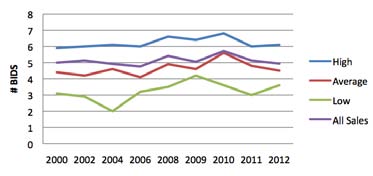 Figure 1. Bids per Sale by Quality and Year The 11-year averages are 6.2, 4.7, and 3.2 bids per sale for the respective quality groups. As stated in the 2010 report, the higher number of bids in 2010 may be in part due to a decreased volume of timber on the market. The volume of timber reported on the market this year and in the 2011 report has returned to levels submitted prior to the beginning of the recession in 2008.
Figure 1. Bids per Sale by Quality and Year The 11-year averages are 6.2, 4.7, and 3.2 bids per sale for the respective quality groups. As stated in the 2010 report, the higher number of bids in 2010 may be in part due to a decreased volume of timber on the market. The volume of timber reported on the market this year and in the 2011 report has returned to levels submitted prior to the beginning of the recession in 2008.
VOLUME RETURNS TO PRE-RESCESSION LEVEL: A total stumpage volume of 25,164,871 board feet were sold during the current period which is very similar to last year’s 24,367,251 board feet. Both years are up considerably from the 17,687,648 board reported during the 2010 reporting period and 19,256,439 board feet reported in 2009. The volume of timber sold in the last two years is very similar to the volume of around 25 million board feet sold in 2008 and 2006.
High quality sales totaled 8,671,566 board feet (8,598,937 in 2011) board feet and approaching the 10 million board feet levels of 2008 and 2006. Medium quality sales totaled 14,428,279 board feet (14,077,574 in 2011) up from the 11 to 12 million board feet from 2010 thru 2006. Low quality sales increased to 2,065,026 board feet (1,690,740 in 2011) but they are still down from nearly 3 million board feet in 2009, 2008, and 2006. The adjustment in the reporting categories that occurred in 2008 likely impacted the volume sold in each grouping with a decrease in the volume of high quality sales due to a drop in ash prices and decrease in low quality sales due to an increase in the price of hickory.
VALUE STABLE: Total timber value sold during the 2012 reporting period was $10,559,277 ($10,678,849 in 2011) up from 2010 and 2009 ($6,889,190 and $7,278,302, respectively) and similar to the values reported in 2008 and 2006 (the volume of timber sold was also similar during these periods). Total value by type was $4,968,313 for high quality ($5,257,530 in 2011), $5,118,780 for average quality ($5,052,387 in 2011), and $472,184 for low quality ($368,932 in 2011).
Prior to 2011, several consultants reported a reluctance to sell high quality timber, last year that activity increased considerably, and although there has been a slight decline this year, activity remains very strong (note that the number of high quality sales that brought over $1,000 per MBF (thousand board feet) on Figure 4). Strong demand for white oak and black walnut fueled much of this activity. Demand for hardwoods commonly used in home construction such as black cherry is still weak while red oak, sugar maple, and tulip seems to be improving slowly, although markets seem to be very volatile for these species.
EFFECTS OF THE ECONOMIC DOWNTURN: Due to the drastic change in the economy in 2008, it was decided in 2009 to collect information on the date of the timber sale in order to track month by month activity.
Previous observations showed that prices appear to have begun to drop thru the fall of 2008 until bottoming out in June 2009. Prices since are mostly trending upward although fluctuating (Figure 2).
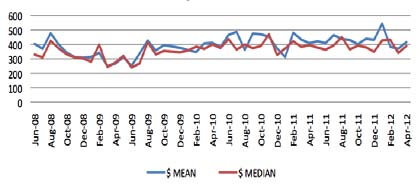 Figure 2. Average Stumpage Price ($/MBF) by MonthThe fluctuations are likely caused by multiple factors including logging conditions that influence log supply at the sawmills, seasonal demands or restrictions, and concerns over the general economy. The median price seems to be a better indicator due to less influence of higher quality sales that can distort the average price.
Figure 2. Average Stumpage Price ($/MBF) by MonthThe fluctuations are likely caused by multiple factors including logging conditions that influence log supply at the sawmills, seasonal demands or restrictions, and concerns over the general economy. The median price seems to be a better indicator due to less influence of higher quality sales that can distort the average price.
Most stumpage prices are nearing levels prior to the recession (Figures 3 and 4). Prices for high quality sales appear to have dropped slightly this year, however, that reduction may be in part due to the composition of the high quality sales for each year. After excluding one sale from late 2010 (also excluded last year) the average price for all sales only dropped from $430 to $420 per MBF.
STUMPAGE PRICE RECOVERING WELL: Stumpage prices for all sales, high quality sales, average quality sales, and low quality sales held from April 16, 2011 thru April 15, 2012 have a normal distribution (Figure 5). High quality sales generally have a wide range of stumpage prices due to higher quality timber or veneer potential. All sales, regardless of quality, can be affected by sales with a potential veneer component. It is important for landowners to realize their timber typically will fall within the range of stumpage prices, but probably will not fall into the outlying values. This makes it important to work with a professional when selling timber so that you know what you have. For example, a few walnut trees can greatly distort the value of a low quality improvement sale dominated by pallet material.
The average stumpage price of high quality sales was $573 per thousand board feet (MBF) down slightly from $589/MBF (2011) but up from $532/MBF (2010) and similar to $572/MBF in 2009 (median price was $568 in 2012 down from $592/MBF in 2011 but up from $498/MBF in 2010 and $549/MBF in 2009) (See Figures 3 and 4).
The average stumpage price for average quality sales was $355/MBF which is similar to $359/MBF in 2011 and $347/MBF in 2010, and up $320/MBF in 2009 (median price was $349/MBF which is similar to $358/MBF for 2011 and $352/MBF in 2010 and up from $314/MBF in 2009). The median price for average quality was similar to the median stumpage price in 2008 ($359/MBF) and 2006 ($357/MBF) (See Figures 3 and 4). 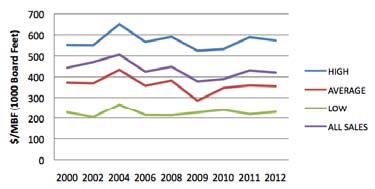 Figure 3. Average Stumpage Price by Year
Figure 3. Average Stumpage Price by Year
The average stumpage price for the low quality sales was $229/MBF up slightly from $218/MBF with a median price of $229/MBF up slightly from $217/MBF in 2011 and similar to $239/MBF in 2010 and $225/MBF in 2009 (median price $234/MBF vs. $228/MBF in 2010 and 2009, respectively). Some of the fluctuation in the price offered for the low quality sales is likely due to the fluctuation in the operating costs associated with the cost of fuel. Manufacturing activity and the supply of timber on the market have the most impact, however, lower valued timber are impacted more by operating costs since the margins are tighter (See Figures 3 and 4). 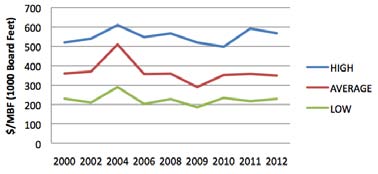 Figure 4. Median Stumpage Price by Year
Figure 4. Median Stumpage Price by Year
The weighted average stumpage price by sale type (obtained from this survey in 2000, 2002, 2004, 2006, 2008, 2009, 2010, 2011, and 2012) is reported in Figure 3. The weighted average of the stumpage price is the total value ($) for each sales group (high, average, low) divided by the total volume by sales group. The median stumpage price by sale type per year is reported in Figure 4. 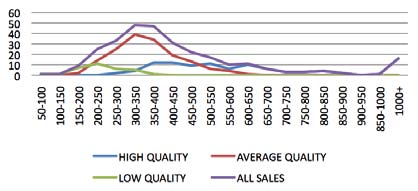 Figure 5. Stumpage Price ($/MBF) by Sales The median price, reported per thousand board feet (MBF) of standing timber, is the amount where half of the sales are higher and half are lower. To obtain a price per board foot, divide the price by 1000. An average price of $378 per thousand (MBF) is the same as 37.8 cents per board foot stumpage. The average stumpage price for all sales was $420/MBF, $573/MBF for high quality sales, $355/MBF for average quality, and $229/MBF for low quality. A statistical summary for all three sale types is given in Table 1.
Figure 5. Stumpage Price ($/MBF) by Sales The median price, reported per thousand board feet (MBF) of standing timber, is the amount where half of the sales are higher and half are lower. To obtain a price per board foot, divide the price by 1000. An average price of $378 per thousand (MBF) is the same as 37.8 cents per board foot stumpage. The average stumpage price for all sales was $420/MBF, $573/MBF for high quality sales, $355/MBF for average quality, and $229/MBF for low quality. A statistical summary for all three sale types is given in Table 1.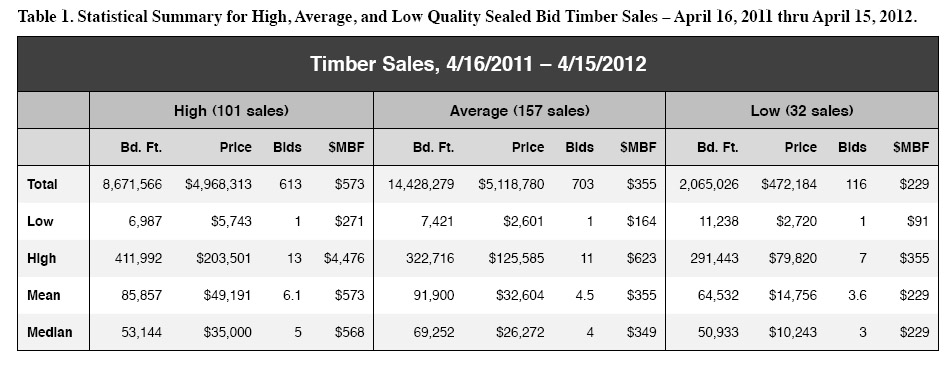
SUMMARY: While the last few years have been very volatile, things are looking up. Prices, for the most part, have returned to levels prior to the recession (although not to housing boom levels) so more timber is going on the market. The larger trees and better quality timber as usual has the most demand. Demand for some species, such as black walnut and white oak is strong and is largely responsible for the variability in stumpage prices for high quality sales. Markets for larger, straight ash and good “white” soft maple are good. Red oak, sugar maple, and tulip prices are volatile but showing promise. The price paid is likely influenced by tree size, quality, location, and immediate demand (spot markets). Black cherry markets are still weak. It is likely some species may not return to the high levels seen during the “high demand years” associated with the housing boom over the last decade or so. Fortunately much of the timber from Indiana is high quality and in demand throughout the world and Indiana’s forest industry has positioned itself well to compete in the global marketplace.
Demand for low quality timber, especially if near low grade mills is strong, although higher operating costs associated with fuel prices are having an impact on the prices paid. It is important to remember that low quality sales are generally improvement cuts where trees are harvested that are impeding the growth of future higher value crop trees. Therefore, the opportunity costs of leaving the trees may cost more in future lost productivity, so it generally is not advantageous to delay selling lower quality if the price is reasonable.
The industry still seems to be carrying a smaller inventory and cutting sales quicker than in the past, creating more of a spot market for timber sold. There still is some reluctance from some consultants to market some species.
The comment section below is offered to our readers by the consulting foresters who participated in this survey: Some of the volatility in the markets is evident based on the comments received.
• The higher costs of operating for loggers and sawmills is impacting timber prices.
• Fuel prices are a big concern and have increased the work bill therefore lowering the bid prices and / or lowering the competition by reducing travel distances.
• Most mills are keeping lower inventories of standing timber than in the past, especially with high quality timber.
• Better terms still matter in this economic climate.
• Demand for standing timber strong last summer and fall. Appears to be continuing into 2012.
• Sales this spring have shown less interest with bidders concerned about the economy.
• Demand strong for low grade timber especially when in close proximity to the mill.
• Larger diameter trees in high demand, I attribute this mostly to productivity issues (higher costs) of processing smaller trees.
• Coming out of the recession demand and prices paid for standing timber are still low. But I think they will improve over the next two years, therefore I am recommending to my clients to wait to sell timber if they can. I am proceeding with sales that are primarily improvement cuts, storm damage, and ash salvage.
• White oak demand strong, especially for higher grades and larger diameters
• Walnut demand still strong, although there are some seasonal variations.
• Walnut demand has slipped slightly, but larger high grade trees still draw a lot of interest.
• Ash is moving well, especially larger, better quality trees that are still alive.
• Soft maple, if white, is moving very well.
• Tulip is in high demand, especially if the trees are clear and larger diameters.
• Black cherry markets still soft, so delaying marking when healthy.
• Red oak, sugar maple and tulip prices volatile and hard to predict.
• Tougher grading of delivered logs, particularly red oak, sugar maple, and cherry.
• Appears to be a large volume of timber moving, I suspect some owners need money and are selling directly to buyers with no professional advice.
- Seeing more high graded stands than ever while working on adjacent landowners.
- Landowners are still inquiring about diameter limit cuts…had hoped these ill conceived method would have disappeared by now.
• Have noticed an inordinate amount of invasive plants taking over recent harvest sites if not controlled prior to harvest. Better harvest planning is needed.
Consulting Foresters that have contributed to this report in alphabetically order include: Arbor Terra Consulting (Mike Warner), Crowe Forest Management LLC (Tom Crowe), Christopher Egolf, Gandy Timber Management (Brian Gandy), Gregg Forestry Services (Mike Gregg), Habitat Solutions LLC (Dan McGuckin), Haney Forestry, LLC (Stuart Haney), Haubry Forestry Consulting, Inc. (Rob Haubry), Multi-Resource Management, Inc. (Fred Hadley, Thom Kinney, Justin Herbaugh), Meisberger Woodland Management (Dan Meisberger), Nelson’s Consultant Forestry (Jack Nelson), North Slope Forestry (Don Duncan), Pyle Timber Sales and Management (David Pyle), Schuerman Forestry (Joe Schuerman), Stambaugh Forestry (John Stambaugh), Steinkraus Forest Management, LLC (Jeff Steinkraus), Turner Forestry, Inc. (Stewart Turner), and Wakeland Forestry Consultants, Inc. (Bruce Wakeland).
